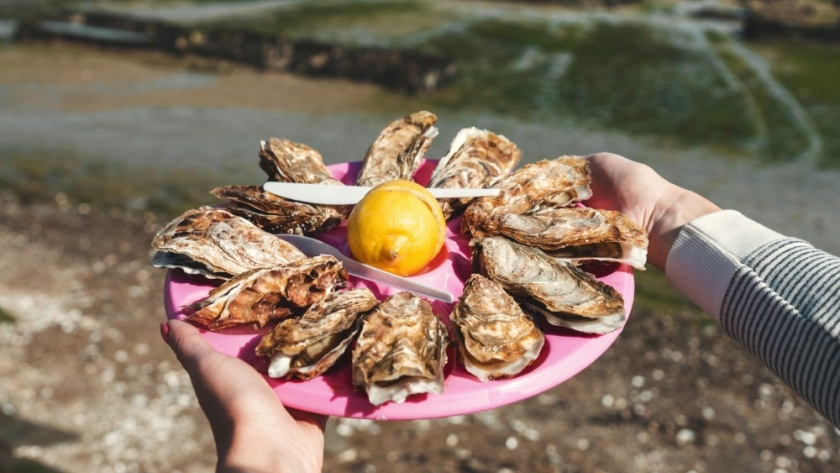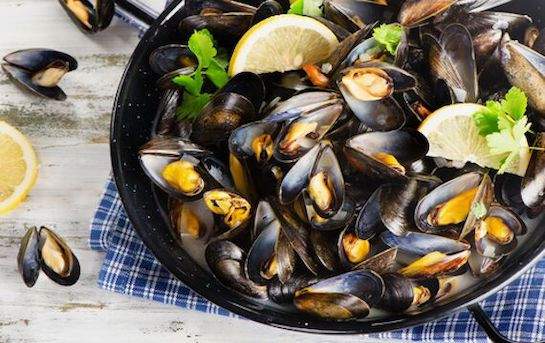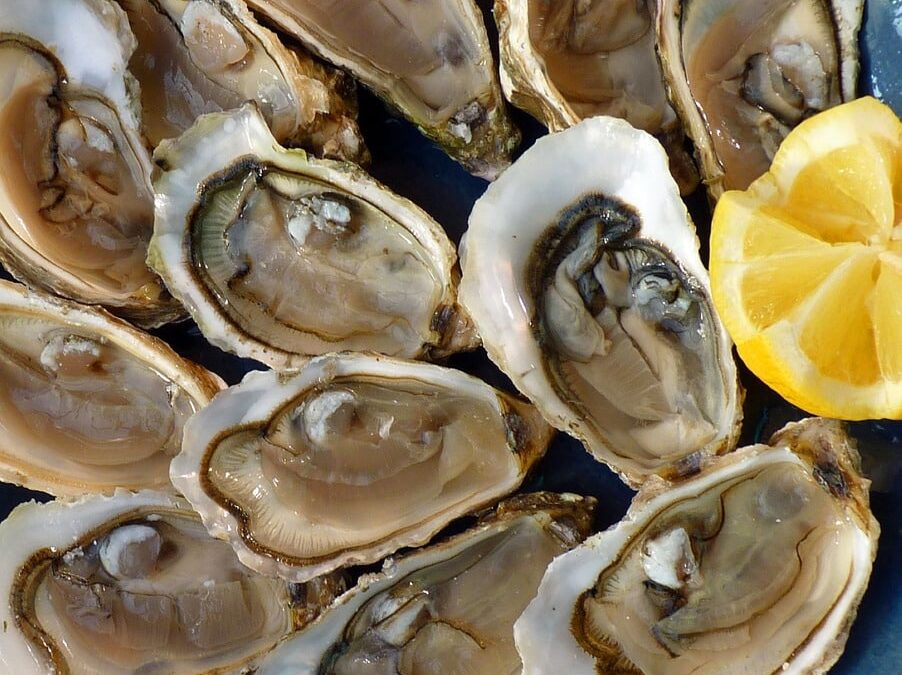
Like many people before me, I didn’t have any plans to visit Brittany until after I moved to France. My travels prior to living in the country had included what I had assumed were the greatest culinary hits, brasserie hopping in the City of Lights and tasting through all the main wine-growing regions. It wasn’t until moving my family to Paris that I began hearing more about this westernmost region. I listened as Parisian chefs proudly proclaimed when an ingredient came from Brittany, watched as neighborly dinner parties ended with cakes of the Breton persuasion, and took notes as friends and colleagues raved about the meals they’d had while on the Brittany coast.
My first visit was love at first sight. Even before tasting a single bite, I became enraptured by the wind-shaved cliffs, the earthy scent of the marshlands, and the way the salty sea air sweeps over the long sandy beaches during low tide. The tribal Celtic roots and seafaring traditions linger through the stalls during market days — where lamb raised on the salty marshland grass is sold near ice beds crawling with wiggly blue lobsters — and the landscape is intimately intertwined with the cuisine.

Oyster farmers still set up daily on a pier in Cancale to sell directly to locals and visitors, which was exactly where I chose to have my first encounter with the famous flat oysters of the region. A half dozen plate of fresh oysters only set me back 6€, and I ate them from my perch on a cement staircase that led to the sea’s edge, letting my son toss the shells back to the sea just as soon as I’d swallowed each briny morsel.
Brittany has a raw appeal, where the regional cuisine is less about preparation as it is about the purity of the ingredients used. Soil-grown strawberries, sweet pink onions, and hand-milled grains are prized possessions, each savored only at their peak ripeness. It’s a place where eating is experiential, and as I cracked shells beneath the shadows of a seafood tower and helped my toddler smear salty butter onto fresh slices of rye, it became clear to me why this region is so beloved by so many.
My shopping list grows longer with each visit, but the essentials remain the same. Here are the 15 essential foods to eat — or bring home — from my favorite food region.
There are few things more Breizh (the local name in the Breton language) than a towering platter of crustaceans served on a bed of seaweed, never ice, to preserve the flavor. Look for plateau de fruits de mer or assiette de fruits de mer on menus, ideally anything containing a mix of cooked and raw shellfish, like brown crab, prawns, langoustines, oysters, periwinkles, whelks, cockles, and clams. Bretons prefer to eat their fruits of the sea as close to the sea as possible — Au Pied d’Cheval in Cancale and Chez Jacky in Port de Belón are favorites — and always with a side of rye bread with salted butter.
/cdn.vox-cdn.com/uploads/chorus_image/image/66239725/seafood_tower_loch_bar.0.png)
Butter in Brittany was originally salted to make it last longer, using salt harvested from Guérande to preserve the full flavor of the milk. Butter making is an artform for Jean-Yves Bordier, who still makes butter the traditional way (which includes kneading and forming it by hand) from his workshop in Saint-Malo. Buy his butters at Maison du Beurre — you can go traditional or try his range of flavored butters, even his Salé 4%, which has crunchy salt crystals — or taste them in action at his restaurant Bistro Autour de Buerre.
From July to January, these iodine-rich bluish-black mussels are on menus throughout the region, stuffed, steamed, or bathed in a broth of white wine, shallots, and parsley as moules marinières. Mussels from the bay of Mont Saint-Michel have a protected designation of origin, and you can enjoy a mind-bendingly delicious pot for around 10€ from the no-frills roadside stand Dégustation Tonneau in Vivier-sur-Mer.

While the rest of the country has been making wine, Bretons have been honing their cider-making skills. Breton cider can be sweet, semi-dry, or dry, but the preference for most cider makers leans to the dry side. You’ll see the drink served alongside galettes (buckwheat pancakes) in ceramic “cider bowls” that look like oversized teacups. You can visit the cidreries themselves — I like Cidrerie Sorre and Cidrerie Manoir du Kinkiz — or sample through the more than 60 ciders at Le Sistrot cider bar in Quimper. If you’re looking for a special souvenir, bottles from Cidrerie Nicol are considered the “Champagne of Brittany.”
The national dish of Brittany, crêpes are thin pancakes served sweet or savory (although in portions of the region, “crêpe” only refers to the sweet version, where “galette” refers to the savory version made with buckwheat). Most crêperies will serve a range of galettes and crêpes, whether they’re simply dusted in sugar, slathered in salted caramel, or carefully folded to reveal a center of egg, ham, and cheese. Le Comptoir Breizh Café serves some of the most loved versions in the region, but you can’t go wrong with any place holding a “Crêperie Gourmande” designation.
There is no shortage of oysters throughout Brittany, and during low tide you’ll see hundreds of oyster beds peaking up along the shoreline in many of its coastal villages. There are 12 oyster growing areas, but many agree the best come from Cancale, and they even have a place on France’s Intangible Cultural Heritage list. Order them by size directly from the farmers at the Marché aux Huîtres in Cancale — sizes range from n° 5 to n° 0; the bigger the number, the smaller the oyster — and eat them on the spot with a glass of dry white wine (which you can purchase on the pier). Once you’re done, the tradition is to toss the empty shells into the sea.

This traditional cake has a texture similar to a flan and is traditionally made with full-fat milk and prunes, since those were historically what the sailors used to bring back from their time away. If you’re invited to a Breton’s house, there’s a decent chance you’ll be served a thick slice of this simple dessert. You’ll find them at most boulangeries in the region, like Le Barbier Joël in Arzon and Gât & Vous Boulangerie in Dinan.
These prized pink onions are revered by chefs for their delicately fruity scent and slightly sweet flavor (also because they cook quicker than other onions). “Onion Johnnies” used to deliver the crop door-to-door by bicycle, and today bunches of onions are braided together by their stems and draped over bicycles as they’re paraded through town during the Roscoff Onion Festival (typically the third week of August). After the festival, you can find these onions in farmers markets and on menus, like at Le Brittany Restaurant in Roscoff or La Pomme d’Api in Saint-Pol-de-Léon.
It’s on the Brittany side of the Mont-Saint-Michel bay, between the land and the sea, where these AOP (a protected designation of orgin) lambs graze on the salty grasses of the marsh (prés salés means salt marsh). Chefs praise the meat for its lightly iodized flavor and near perfect marbling, and you can find it on menus at Auberge du Pont d’Acigné in Noyal-sur-Vilaine, Brasserie du Sillon in Saint-Malo, La Table des Pères in Piré-Chancé, and Le Bistrot de Cancale in Cancale.

Referred to as “le petit bleu,” these deeply blue-hued lobsters are deeply satisfying, with a natural saltiness and meaty texture. You can buy them straight from the boat in Plouguerneau if you have a pot to cook them in, otherwise it’s best to leave it to the pros, like Olivier Belin at Auberge des Glazicks and Jonathan Bigaré at La Gouesnière.
The origins of this ubiquitous treat are pure Breton, or at least pure Breton butter, when chocolatier Henri le Roux made his first batch of caramels with salted butter. The recipe caught on, and some of the top places to sample these sweet and salty treasures are at Grain de Vanille in Cancale (Note: It's also worth ordering the Le Mille-Feuille à la Vanilla Bourbon while there) and Au Petit Prince in Étel. Local liquoriste Fisselier even makes a La Fleur de Caramel liquor that I happen to know is incredible when drizzled on ice cream.
Brittany’s history as part of the spice trade — specifically in the southern town of Port-Louis — has peppered the region with a love of signature blends (check out the boutique spices at Épices Rœllinger). One of the most loved local blends is a curry powder named after the secret recipe shared from a shipwrecked sailor to a local apothecary. Kari Gosse curry is the base for many local lobster curries, and blends ginger, turmeric, chili, cinnamon, pepper, and clove. Find it in pharmacies in Auray, La Cale aux Épices in Paimpol, or Groix et Nature — when it’s not sold out.

Brittany has many delicious cakes and pastries, but few more famous than this decadent multilayered cake. Kouign-amann translates to “butter cake,” so it’s no surprise which ingredient shines beneath the crunchy exterior of this salty-sweet dessert. Sample some of the recent award-winning versions at Pâtisserie Aux Choux à Lié in Ploeuc-L’Hermitage or Zest de Gourmandise in Iffendic.
The secret ingredient that makes these jewel-toned berries burst with flavor lies in the perfume of the Breton soil. While other strawberry farmers opt for hanging gardens or green houses, Breton farmers expose their crops to the terroir of the land, and the result is intoxicating. Pick them fresh each spring at La Ferme du Goazio in Trieux valley or Fraises Patrick Séché in La Baule, grab them from a farmers market, or eat them as a sorbet from Glacier Jampi or Alain Chartier.
Most of the buckwheat products in the region will be in the form of galettes or sables (i.e., cookies), but the beekeepers at Fleur de Ciel are making a honey that infuses the woody fragrance of buckwheat directly into the jar. It’s loaded with antioxidants and vitamins, but it’s also just really tasty drizzled on a freshly plated crêpe.
Food & Wine
